Point 27 of the Catechism of the Catholic Church summarizes the deepest and most genuine aspect of our human nature: "....The desire for God is inscribed in the heart of man, because man has been created by God and for God; and God never ceases to draw man to himself, and only in God will man find the truth and happiness he never ceases to seek.".
Only the human being is capable of knowing and loving beyond the material and finite. As a spiritual being, like God himself, he can know and love him: the creation of man in the image of God implies the possibility of a relationship of mutual communication. And precisely for this reason, by being in God's image and thus participating in Him, who is pure love, man is a being capable of loving Him, and he does so through a life of prayer.
We are earthly, but we long for the eternal, which is God. A God we can deal with, whom we can address and love, as we will now discuss.
What is prayer? Why and what is prayer for?
– Supernatural prayer is a dialogue with God, and not a "magic wand", as Pope Francis points out.
We call our conscious and colloquial relationship with God prayer. The word "prayer" comes from the Latin verb precorwhich means to beg, to go to someone requesting a benefit. The term "prayer" comes from the Latin noun oratiowhich means language, speech, discourse.
It would be to elevate the soul to God or to ask him for the goods that are convenient for us. It would also be in essence a family conversation, a union of the man who considers himself a son, with God, his father.
Prayer is indispensable for the spiritual life. It would be like breathing, which allows the life of the spirit to advance.
In prayer we actualize our faith in God's presence, we foster the hope that leads us to direct our lives towards him and to trust in his providence. And we enlarge our hearts by responding to divine love with our own love.
On the other hand, in the life of prayer, the Liturgy -and, at its core, the Eucharist- is of vital importance, for through it, or in it, the soul is united to Christ, the model and way of all Christian prayer.
Various ways to pray?
Yes, we used to say that to pray is to dialogue, to speak, with God, about what: as St. Josemaría Escrivá would point out, "...".of Him, of you: joys, sorrows, successes and failures, lofty ambitions, daily worries..., joys and sorrows: and thanksgivings and petitions: and Love and atonement. In two words: to know Him and to know you: "treat each other!" (The Way, 91).
There are a thousand ways to pray, and we do not need an artificial, rigid method to address our Father. If we love, we will know how to discover personal, intimate ways that lead us to this continuous dialogue with the Lord.
One way is "mental" prayer. One can imagine the Gospel scene from the life of Jesus and meditate on it. Then apply one's understanding to the object of considering the concrete trait of the Lord's life that the passage suggests to us. And finally to tell him what usually happens to us, what is happening to us. After that comes listening, because God speaks, he responds to those who question him, with interior motions, seeing the answer to the questions that we have been able to ask him.
This does not consist in making pretty speeches or consoling phrases. It is also sometimes a look at an image of Jesus or Mary; at others, the offering of good works, of the results of fidelity; and always looking for Jesus, and not for oneself.
To pray we must rely on the Holy Spirit, who teaches us and reminds us of all that Jesus said, and also educates us in the life of prayer, arousing expressions that are renewed within permanent forms of prayer: blessing God, asking for forgiveness, imploring Him for what we need, thanking Him and praising Him.
We can also turn to "vocal" prayer, or those prayers that we learned, perhaps as children, and others that we have incorporated throughout our lives: the Our Father, Hail Mary, Holy Rosary, etc.
– Supernatural Holy Mass and other liturgical acts would also be prayer, of course, dispensing a divine grace of its own.
On the other hand, we have the "intercessory" prayer, which consists of a petition on behalf of another. It knows no frontiers and also includes our enemies. It is based on the trust we have in our Father God, who wants the best for his children and attends to their needs.
Finally, we should refer to prayer "of thanksgiving," since every joy and every sorrow, every event and every need can be a reason for prayer of thanksgiving; and to prayer "of praise," totally disinterested, which is addressed to God; it sings for Him and gives Him glory not only for what He has done but for being Who He is (cf. Catechism of the Catholic Church No. 2644-2649).
Prayer in daily life.
We observe how in the Old Testament Abraham, Moses and the prophets spoke and listened to God. In the New Testament, Jesus teaches us how we can relate to our Father God.
Prayer has had many experiences throughout the centuries. The saints are a clear example of the fact that in every age and circumstance God seeks each person and that each person can respond to Him by entering into a true dialogue with Him.
Regardless of their beliefs, all men and women are called to communicate with God, as we said. Through creation, God calls every being from nothingness into existence. Even after having lost, through his sin, his likeness to God, man continues to be the image of his Creator: he continues to long for the One who created him and does not cease to seek him. By entrusting our lives to him, by sharing with the Lord all that we do or the state in which we find ourselves, we already pray.
God calls each person to the mysterious encounter of prayer. It is he who takes the initiative in prayer, placing in us the desire to seek him, to speak to him, to share our life with him. Thus, whoever prays, whoever is ready to listen to God and to speak to him, responds to this divine initiative.
When we pray, that is, when we speak to God, it is the whole person who prays. But where does prayer come from? From the soul or from the spirit, according to Sacred Scripture; and more often, it is the heart that prays.
It is in the heart, in the depths of our being, that the personal encounter of each one of us with God takes place.
Prayer, however, requires, as the Catechism of the Catholic Church emphasizes in Nos. 2559-2564, that we want to pray and learn to pray, and we do this through the Church: listening to the word of God, reading the Gospels and, above all, imitating the example of Jesus.
How does Christian prayer differ from the "prayer" of other religions or pseudo-religions?
The main difference of Christian prayer with respect to the forms of some other forms of prayer is that it spiritualist trends lies in the search for a personal encounter with God, which is different from a simple individual search for peace and inner balance. This is what we referred to in our article of last February 1, when commenting on pseudo-religions and the new age.
Christian prayer is always determined by the structure of the Christian faith. It is Christ himself who teaches us how to pray, which means praying within his mystical body, which is the Church.
Christian prayer also has a communitarian dimension. Even in solitude, it always takes place within that "communion of saints" in which and with whom one prays, both publicly and liturgically, as well as privately.
The Christian, even when alone and praying in secret, has the conviction to pray always in union with Christ, in the Holy Spirit, together with all the baptized, for the good of the universal Church, present, past and future.








